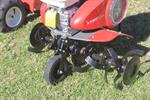1. Surveying
2. Earthworks
3. Water management
4. Environmental control
5. Chemical applications
6. Fencing
7. Mechanisation
8. Engineering efficiency
9. Developing engineering solutions
Cultivating Soil
Soil is cultivated to make it looser, sometimes so it can be shaped or moved easier; sometimes so you can mix other things into it, and sometimes to prepare it for agricultural or horticultural use.
Don't cultivate soil unless you have a reason though!
Cultivation of soil may be carried out for one or all of these reasons:
- To control weed growth (in this case the cultivation does not need to be very deep. A cut one inch below the surface is sufficient to severely disrupt weed growth. This may be done to kill or remove weeds, before moving earth or changing levels.
- To remove rubbish buried in the soil (e.g. tree stumps, rocks, builders materials, etc) Cultivation can be used to bring such materials to the surface, loosen them in the earth, and/or drag them from the area to be worked.
- To loosen earth so that it can be dug, removed or shaped more easily.
Deep cultivation in some situations can destroy the natural soil profile, creating drainage and other problems. Heavy cultivation (or the weight of heavy machinery), close to or in a water holding area (e.g. watercourse, dam or lake) can crack the impervious layer in the soil which holds the water. In this way, for example it is in fact possible to destroy the natural flow of a creek (by doing construction work over or around it during the dry season).
Chisel Ploughs
Chisel ploughing consists of pulling heavy cultivators tines through the soil at a greater depth than conventional ploughing. This action breaks up or bursts the underlying layers of soil with bringing the subsoil to the surface (as opposed to the soil turning action of other ploughs). These ploughs are useful for improving drainage, aerating the soil, breaking up soil pans and pulling up deep-rooted weeds.
Disc Ploughs
This consists of a series of discs mounted individually at an angle to the ground. Drawn behind a tractor they rotate as they cut the soil. The tilted angle helps to turn the soil over but decreases the depth of the cut.
 Rotary Cultivators
Rotary CultivatorsRotary hoes can be either self propelled units (common in earthworks for a home garden) or tractor mounted units. This type of machine mixes the soil more thoroughly than most other types of cultivators. Rotary hoes will bring buried materials to the surface, allowing the ground to be cleaned up. As such, it can be more destructive to the soil profile. In situations where the soil profile is not of significant concern, the rotary hoe is perhaps the most efficient machine.
Disc Cultivators or Harrows
Similar to disc plough but with discs closer together and mounted in pairs. They are comprised of a number of sets (gangs) of concave discs which can be set at variable angle to the direction of travel. The greater the set of the disc angle, the more severe the resulting disruption of the soil. The discs turn and breakdown the soil surface.
Spring Tined Cultivators and Scarifiers
These tractor mounted cultivators are more like single fixed spikes which are dragged through the soil. While ripping and loosening the soil this type of implement does less mixing of soil than the disc or rotary implements. As the tines are drawn through the soil the flexibility and movement of the tines allows them to vibrate and this helps break down soil clods.
THIS COURSE CAN HELP YOU TO:
- Better understand how to use engineering solutions in a range of jobs.
- Gain confidence in this field.
- Use this course for professional development in your current position.
- Make you more knowledgeable and employable.
WHAT SETS ACS APART?
At ACS we provide you with more than just a set of course notes.
Your 'learning package' includes:
- Course notes.
- Self-assessment quizzes.
- Assignment feedback.
- You can interact one on one with a professional tutor with decades of experience - just email, phone or log on to chat to connect with them.
- Depending upon your course, your studies may involve independent research, interviews, practical exercises, assessments, Problem Based Learning projects, and more.